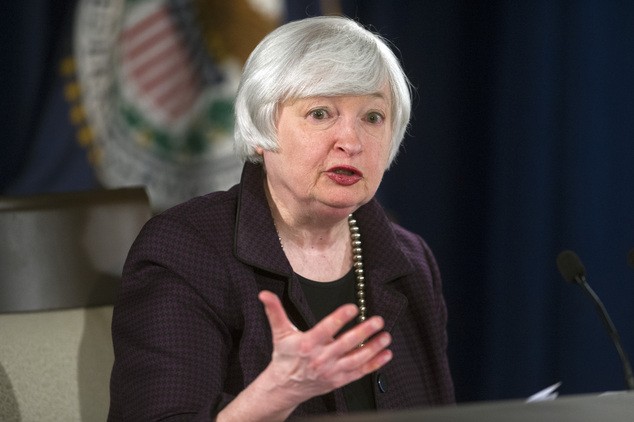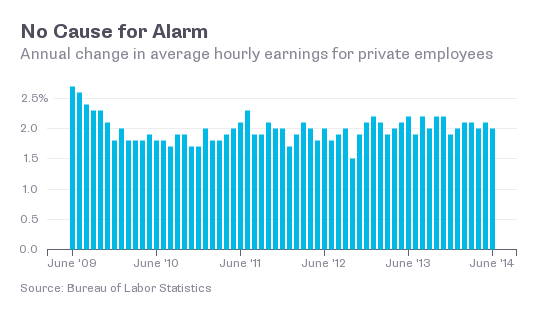Yellen Versus the Inflation Hawks
Post on: 16 Март, 2015 No Comment

13 Jul 3, 2014 12:13 PM EDT
The U.S. economy added a whopping 288,000 jobs in June — even better than expected. Unemployment dipped to 6.1 percent, the lowest since September 2008. The major stock market indexes are setting almost-daily records. Manufacturing is booming. Housing is rebounding. Consumers are spending. Even General Motors Co. eked out a sales increase last month.
It seems the on-again, off-again economic recovery may finally be taking hold. What could possibly go wrong?
Plenty, according to inflation hawks. They’re worried — as they always are — that inflationary pressure is building and a flat-footed Federal Reserve won’t be able to stop the coming wage-price spiral. Interest rates should rise sooner rather than later, they say.
They’re wrong — though they do have a point. Inflation gauges have been moving up a bit of late. Prices rose 1.8 percent in the year to May, according to the Fed’s preferred measure (prices for personal consumption minus food and energy). That number has been rising since February’s 0.8 percent and isn’t far from the Fed’s 2 percent target. The consumer price index (excluding food and energy) clocked in at 2 percent in the year to May.
This doesn’t yet justify bringing forward the first rise in interest rates. The economy’s doing better but could easily stumble again — as it did, and badly, in the first quarter. More important, there’s still ample slack in the labor market. Labor-force participation remains abnormally low. For the fifth consecutive month, the economy has created more than 200,000 jobs — it hasn’t done that since 1999 — yet at this pace it will take at least another two years to reach full employment.
Fed Chair Janet Yellen seems unlikely to be swayed by the hawks. After last month’s Federal Open Market Committee meeting, she said the inflation numbers are noisy. In a talk at the International Monetary Fund yesterday, she affirmed her dovish instincts by saying that interest rates shouldn’t rise to deal with financial excesses either — other tools are more appropriate.
She’s right on both points. But when it comes to jobs and inflation, she ought to be more forceful. She should make it clear that the Fed is willing to allow some overshooting of the 2 percent goal if the labor market remains weak. The target is a target, not a ceiling.
Yellen will also have to wade into the debate over whether long-term unemployment (about 2.1 million people have been out of work for a year or more) helps to keep wages in check. If it doesn’t — if it’s only short-term joblessness that keeps labor costs down — there’s more reason to worry about rising prices.

A recent study by Alan Krueger, the former chairman of President Barack Obama’s Council of Economic Advisers, suggests that the long-term jobless are so disconnected from the labor market that, once job openings pick up, they aren’t enticed back to work. If the long-term unemployed don’t suppress wage inflation, the jobless rate, for anti-inflation purposes, is really only 4 percent. Wages could start rising sooner than expected.
For now, this isn’t a worry. Wages have been quiescent throughout the recovery, with increases hovering around a nominal 2 percent annually. And the number of people working part time and saying they’d prefer a full-time position went up in June by 275,000.
Yellen’s message — that she’s watching for signs of inflation but sees no need yet to change the Fed’s thinking on when to raise rates — is correct. But it’s important to dial up the volume: Investors need to know that the inflation hawks aren’t winning the argument.
To contact the senior editor responsible for Bloomberg View’s editorials: David Shipley at davidshipley@bloomberg.net.














